OSB Boards
(9 Products)Oriented Strand Board (OSB) is a highly engineered, versatile wood panel often used in the construction industry for a variety of structural and non-structural applications. Manufactured by compressing multiple layers of wood strands coated with adhesive in specific orientations, OSB provides exceptional strength and rigidity. This fabrication process ensures that the board can bear heavy loads and withstand significant stress, making it an ideal material for uses ranging from roof and floor sheathing to wall construction.
What is OSB Sterling Board?
OSB, or Oriented Strand Board, is a versatile engineered wood product formed by layering strands of wood in specific orientations.
Its strength comes from the combined heat and pressure application to the wood strands mixed with adhesives. OSB is often referred to as "sterling board" in various regions, highlighting its robustness and reliability in construction.
In terms of its appearance, OSB boards typically feature a particoloured and rough surface since the outer wood strips are laid in a criss-cross manner to enforce the product's strength and durability.
Many contractors use OSB boards as structural panels for roofing, generally roof sheathing, below the outer roofing system. They can also be used as sheathing materials on walls, floors, ceilings and structural elements.
What is OSB Wood Sheet Used For?
- Roofing and Flooring: As a base in roofing and flooring for its durability.
- Wall Sheathing: OSB provides excellent wall covering for structural integrity and insulation.
- Furniture Making: Due to its affordability and strength, it is a popular choice for furniture production.
- Packaging Industry: In packaging, OSB boards are used for creating sturdy, protective containers.
OSB Board Benefits & Key Features
- Relatively easily sealed against the elements - suitable for interior or exterior use
- Standard OSB sheet dimensions: 2440mm x 1220mm (8x4)
- Superb load-bearing properties
- Durable building board
- Cost-effective alternative to plywood
Types of OSB Board
OSB boards come in various types, each tailored for specific applications and requirements. Understanding the differences can help select the right type for a particular project:
- OSB/1: Ideal for interior applications where the conditions are dry. This type is often used for furniture and decorative panelling where moisture exposure is minimal.
- OSB/2: This type is also used in dry conditions but is engineered for load-bearing applications. It's suitable for flooring, wall sheathing, and DIY projects where structural strength is necessary.
- OSB/3: Designed for use in humid conditions, OSB/3 is perfect for environments that might experience occasional moisture. It's commonly used in roof decking and wall sheathing in areas where moisture resistance is crucial.
- OSB/4: The most durable and moisture-resistant version, OSB/4 is suitable for heavy-duty load-bearing applications in humid conditions. This type is ideal for industrial flooring and flat roof decking where higher performance is required.
We stock a comprehensive range of OSB boards to meet various construction needs, including:
- OSB/3 Square Edge: Ideal for humid conditions, this board is designed for durability and moisture resistance, making it perfect for applications like roofing and wall sheathing.
- OSB/3 Tongue and Groove (T&G): This variant offers a precise fit, ensuring seamless joints for areas requiring a continuous, sturdy surface such as flooring systems.
Please note: While we don't stock OSB/1, OSB/2, or OSB/4 on our site, if you are interested in these options, please get in touch with our sales team. We may be able to source these from one of our distributors.
Frequently Asked OSB Board Questions
What Does OSB Board Stand For?
OSB stands for Oriented Strand Board, which perfectly summarises its manufacturing process. The strands of wood are turned, or “oriented” in opposing directions to strengthen the board layer by layer then fixed together using UF glue (Urea Formaldehyde).
The result is an extremely strong load-bearing construction material that creates rigidity and offers excellent cross-dimensional stability.
How Much Do OSB Wood Sheets Cost?
No matter the project, no matter the material, cost is always an important consideration. The fact that OSB is generally cheaper than plywood makes it a winner in our book. Although it is markedly less in price, it is of an equal and excellent performative standard.
In summary, the price you end up paying will ultimately depend on your chosen thickness.
Is OSB Board Waterproof?
Whilst it's not entirely waterproof, OSB is water-resistant and can be sealed to further enhance its moisture performance.
It's as simple as applying a sealant to the surface that requires protection against the elements. A paintbrush should be used to apply the waterproofing solution and it may take 12-14 hours to dry completely.
An important thing to remember is that the OSB board should be cut to size before being sealed as any newly cut edge can potentially allow water to come in, if not appropriately sealed.
To ensure the waterproofing has worked, it is prudent to pour water on the newly waterproofed surface after it has dried and wait a few hours to determine whether the water has managed to get through the waterproof barrier or not.
Can OSB Sterling Board Be Painted?
OSB Board can indeed be painted and this can add to the level of waterproofing on offer as the paint can shield the wood further from water ingress.
It is important to note that if paint is being used, the waterproof sealant should be used on top of the paint, once it has dried as paint is not a substitute for an adequate sealant but can act as an additional barrier to water once the sealant has been correctly added.




















